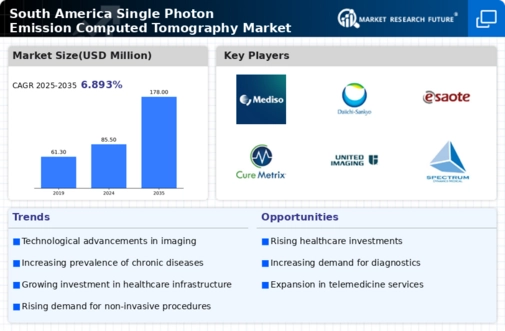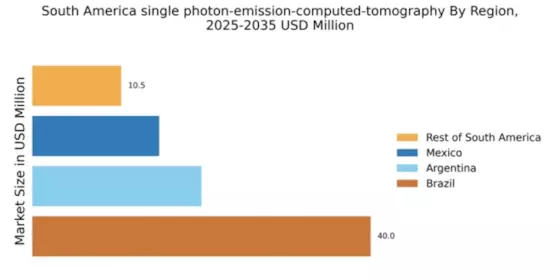Growing Aging Population
The demographic shift towards an aging population in South America is significantly influencing the single photon-emission-computed-tomography market. As the population aged 65 and above continues to grow, the demand for diagnostic imaging services is expected to rise. By 2025, it is projected that approximately 15% of the South American population will be over 65 years old, leading to an increased prevalence of age-related diseases such as cardiovascular disorders and cancers. These conditions often require advanced imaging techniques for accurate diagnosis and management. Consequently, the single photon-emission-computed-tomography market is likely to benefit from this demographic trend, as healthcare providers seek to enhance their diagnostic capabilities to cater to the needs of an older population. This shift may drive investments in SPECT technology, ultimately improving patient outcomes.
Increasing Healthcare Expenditure
The rising healthcare expenditure in South America is a pivotal driver for the single photon-emission-computed-tomography market. Governments and private sectors are allocating more funds towards advanced medical technologies, which includes imaging modalities like SPECT. In 2023, healthcare spending in South America was estimated to reach approximately $500 billion, reflecting a growth of around 5% annually. This increase in investment is likely to enhance the availability and accessibility of SPECT systems, thereby improving diagnostic capabilities. Furthermore, as healthcare budgets expand, hospitals and clinics are more inclined to adopt innovative imaging technologies, which could lead to a higher demand for single photon-emission-computed-tomography systems. This trend suggests a positive outlook for the market, as enhanced funding may facilitate the procurement of advanced SPECT equipment and training for healthcare professionals.
Emerging Healthcare Infrastructure
The development of healthcare infrastructure in South America is a crucial driver for the single photon-emission-computed-tomography market. Many countries in the region are investing in modernizing their healthcare facilities, which includes the integration of advanced imaging technologies. For instance, Brazil and Argentina have initiated several projects aimed at upgrading hospitals and diagnostic centers, with a focus on incorporating state-of-the-art equipment. This investment is expected to create a conducive environment for the adoption of SPECT systems. As healthcare facilities enhance their capabilities, the demand for single photon-emission-computed-tomography systems is likely to increase, facilitating better diagnostic services. The expansion of healthcare infrastructure not only improves access to advanced imaging but also encourages collaboration between public and private sectors, potentially leading to innovative solutions in the market.
Rising Awareness of Early Diagnosis
There is a growing awareness regarding the importance of early diagnosis in South America, which is positively impacting the single photon-emission-computed-tomography market. Patients and healthcare providers are increasingly recognizing that early detection of diseases can lead to better treatment outcomes and lower healthcare costs. This shift in mindset is driving demand for advanced diagnostic tools, including SPECT imaging, which is known for its ability to provide detailed functional information about various conditions. As awareness campaigns and educational initiatives proliferate, more patients are likely to seek out advanced imaging services, thereby increasing the utilization of single photon-emission-computed-tomography systems. This trend suggests a favorable environment for market growth, as healthcare providers strive to meet the rising demand for early diagnostic solutions.
Technological Integration in Healthcare
the integration of technology in healthcare practices drives the single photon-emission-computed-tomography market in South America. The advent of digital health solutions, including telemedicine and electronic health records, is transforming how diagnostic imaging services are delivered. This technological evolution facilitates better data management and enhances the efficiency of SPECT systems. As healthcare providers adopt these technologies, the demand for advanced imaging modalities is likely to increase. Moreover, the ability to share imaging data seamlessly among healthcare professionals can lead to improved patient care and faster diagnosis. The ongoing integration of technology in healthcare settings may thus create a favorable landscape for the single photon-emission-computed-tomography market, as stakeholders seek to leverage these advancements to enhance diagnostic capabilities.


















Leave a Comment